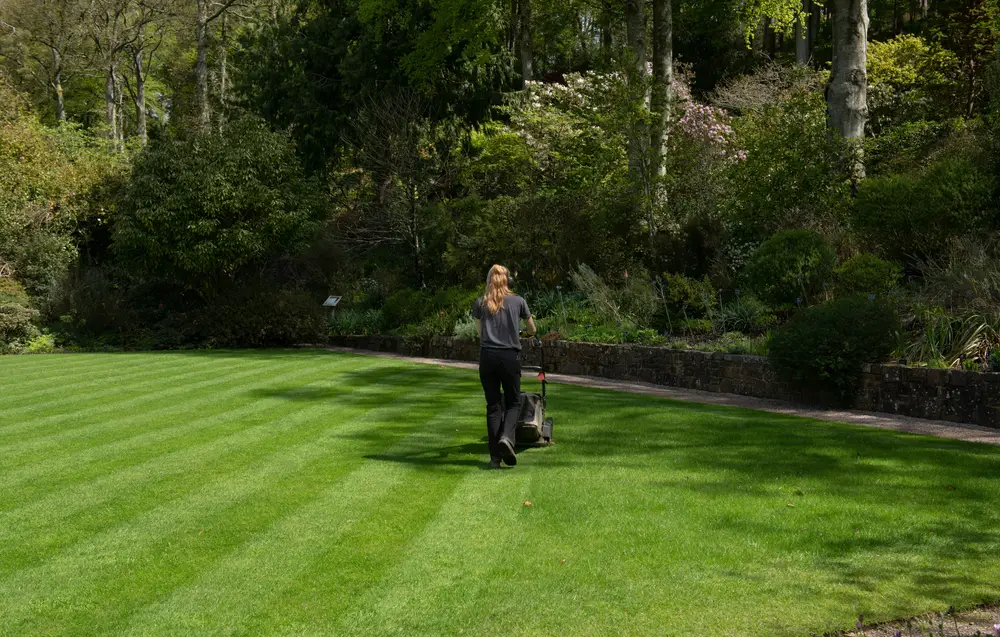In this content you’ll learn:
Key Takeaways
- Knowing how to stripe a lawn with any lawn mower is essential to creating a beautiful-looking and healthy lawn.
- You can stripe your lawn with any lawn mower, although zero-turn lawn mowers are the best since they’re great at turning, and many lawn mowers will need a roller attachment to bend the grass as you mow and create the stripes.
- To create lawn stripes, mow around the edge of your lawn, then mow back and forth from edge to edge either horizontally, diagonally, or vertically until you’ve mowed your entire lawn.
There’s nothing better than a perfectly striped lawn. It gives your yard a well-manicured look that isn’t too showy. I recently striped my lawn, which is something I do from time to time, and the results were fantastic.
But how do you stripe a lawn, and can you do it with any lawn mower? Thankfully, the answers to both of those questions are easy.
Here’s what they are.
How To Stripe Your Lawn With Any Lawn Mower

You can use any lawn mower, from gas to electric, and walk-behind to riding lawn mowers to stripe your lawn (although zero-turn lawn mowers make it easier).
The critical element is the roller (a lawn mower attachment). It bends the grass, thus reflecting light and creating the stripes. So, the heavier the roller is, the better, and some lawn mowers have this feature built-in.
Just remember to lift the roller as you turn to avoid pressing down any grass blades you don’t want to.
You can create stripes without a roller attachment, but they won’t be as visible.
Using a reel lawn mower to create stripes is also possible, but owing to their lighter weight, the stripes may not be as prominent.
With all that in mind, here’s step one to striping your lawn with any lawn mower.
1 – Create A Border
Regardless of the type of lawn mower you are using, the best place to start when striping your lawn is the edge.
Start in one corner of your lawn, mowing in a straight line along the edge. When you reach the opposing corner, turn your lawn mower and continue mowing along the next edge. Repeat this process until you’ve gone all the way around and are back where you started.
You don’t have to create a border, but this will give the lawn a more even and well-manicured finish.
2 – Make The Stripes
Now it’s time to create your lawn stripes.
Again, choose a corner of your lawn to start in, but this time, mow in a straight line next to the border you just made. Note that you’ll need to go in the opposite direction you did when making the border (and you’ll need to overlap the border that’s perpendicular to your stripes).
When you reach the end of your lawn, turn your lawn mower around and mow a stripe in the opposite direction.
Continue doing this from one end of the lawn to the other until you reach the other edge. Now, take a look back and enjoy your beautiful striped pattern!
How To Avoid Obstacles And Still Make Stripes
Maybe your lawn has trees, statues, flower beds, and other features that make mowing a nice, clean pattern difficult. The good news is it’s possible to still mow those great-looking patterns despite these obstacles.
Mowing around obstacles can take some practice, but when you get the hang of it, you can make it look like the stripe runs right through it.
Mow directly up to the obstacle and then around its edge until you return to the original stripe you were making. When you mow the stripe next to it, mow right over the already-mowed obstacle’s edge. This bends the grass the way you want, making the stripe effect you want.
Alternatively, you could mow a border around each obstacle and give your striped or other mowing patterns a unique look.
Tips When Striping Your Lawn

For the best results, follow these tips:
- Change Directions Each Time: Do this even if you stick with the same mowing pattern, as it keeps your lawn healthy.
- Keep Your Lawn Mower’s Blades Sharp: Sharp blades provide your lawn with a clean cut, while dull blades tear the grass, making it vulnerable to pests and disease.
- Keep Your Grass Two Inches Or Higher: Your grass needs to stay this length or longer so the stripes you make will be more visible.
- Do A Second Pass Over The Stripes: Doing this makes them really pop!
- Take Your Time: Any mistakes can increase how much time you have to spend on making this pattern, in addition to potentially ruining the pattern.
Is Striping Good For Your Lawn?
Striping is a great way to keep your lawn healthy. Mowing in one direction can create grooves and ruts in the lawn, depressing the grass and affecting its health. Mowing in different directions encourages healthy growth, giving you a much lusher and greener lawn.
So, striping is a great way to mow your lawn, whether you’re looking for a beautiful pattern, to improve your lawn’s health, or both. Just remember to always mow your stripes different ways. Mowing the stripes the same way every time will have an adverse effect on your lawn’s health as well.
More Advanced Mowing Patterns
A striped lawn is a classic and timeless way to present your grass, but it’s not the only one.
Here are some additional (and more advanced) mowing patterns you can make:
- Checkerboard: First, mow regular stripes, then mow a new set of stripes perpendicular to and over the first set.
- Diamond Checkerboard: Start at the corner of your lawn and mow in diagonal lines. Repeat this perpendicular and overlapping the first set.
- Circles: Start in the center of your lawn and mow a small circle. Move your lawn mower to the outside of the circle and mow another one around it. Continue this until you reach the edge of the lawn. This may not be possible when using a riding lawn mower, although it is with a zero-turn model.
